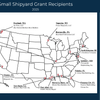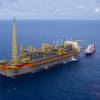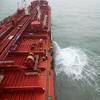According to a leading classification society, the "torque limiting device" requirement for a single diesel engine installation can be waived when a coupling monitoring device is installed.
The U.S. Maritime Administration (MarAd) employs Vulkan Monitoring Devices on Ready Reserve Force ships to enable a crew to recognize changes in a ship's propulsion system that are not identified by standard alarm systems. The Ready Reserve Force (RRF) was established in 1976 and provides prompt sealift support for rapid deployment of U.S. military Forces for peacekeeping or humanitarian missions.
Early in the Bosnian conflict, the U.S. was called upon to supply sealift capability to move NATO vehicles, ammunition and support equipment to Croatia. Two MarAd RRF ships were called upon to carry NATO's cargo in support of Britain's 24th Air Mobile Brigade. The Cape Race and the Cape Diamond carried more than 92 percent of the total cargo transferred from the U.K. to Croatia. Included were 2,015 military vehicles, 232 containers and 3,629 pallets of breakbulk cargo.
In December 1998, the Cape Race was called up again, along with the Cape Rise, to return to Bosnia. MarAd maintains these ships in reduced operating status, with 10-person crews, ready for sailing within four days notice. The Cape Race and Cape Rise were fully crewed and underway within 48 hours. These ships, along with the Cape Ray, are operated for MarAd by Intrepid Ship Management, Inc., and are homeported at Moon Engineering Co., Portsmouth, Va.
The Cape R class ships are RoRo vessels with stern and side ramps, permitting wheeled vehicles to be loaded and discharged without cranes. Each has a total of 138,890 sq. ft. of deck space, and four elevators to move cargo between decks. The vessels are 648 ft. (197.5 m) long and 105 ft. (32 m) wide. Operating draft (depending on cargo load) is 25 - 28 ft. (7.6 - 8.5 m) With a service speed of 18 knots, the vessels have an operating range of 21,000 nm.
The propulsion plant consists of twin Kawasaki-MAN 14V 52/55 (14,000 hp @ 430 rpm) four-stroke medium speed diesel engines fitted with exhaust gas turbochargers and integral air coolers. The main engine couplings are Vulkan EZ-360-S flexible couplings. Both engines connect to one Kawasaki Heavy Industries double helical, single reduction gearbox. The main engines also have PTO shafts that drive, via another Vulkan coupling, the main generators.
The Cape Race, Cape Rise and the Cape Ray are maintaining their high state of readiness with continual maintenance and periodic system upgrades. In early summer of 1999, the ships upgraded their Vulkan monitoring devices by installing new circuit boards and leads to the Vulkan EZ-S couplings.
The Vulkan Coupling Deflection Monitor is a two-channel monitoring system that measures the twist of the couplings. Magnetic pickups, on the drive and driven sides of the coupling, measure the degree of deflection and trigger an alarm when the preset angle of twist is exceeded.
The more sophisticated Vulkan Monitoring and Diagnostic System (MDS) can monitor up to four measurement points on a single row or multi-row coupling. Individual signals or the differential signal between two input channels can be monitored. Signal processing takes place continuously in the background, while on the display, a limiting parameter can be set or adjustments can be made. If pre-set limits are exceeded, an audio or visual alarm will be triggered. The notice of alarm is registered and the condition that led to the alarm is recorded by means of a "time-window," which stores the conditions present in the system for a stipulated period prior to the alarm being triggered.
When monitoring the total speed range, including "Start/Stop," four different alarm conditions can be set. This eliminates false alarms generated by passing through a particular resonance.
The monitoring of a measured variable takes place after analysis of the signal. Following variables can be monitored:
•the mean twist angle
•the dynamic twist angle with amplitude of the total sum
•vibration and amplitude of each single order
•transient conditions such as shock load or start/stop maneuvers
Installing monitoring devices on a vessel's couplings is a proactive approach to vessel safety and maintenance ensuring problem free operation. Using the data from the monitoring devices, effective inspection and maintenance programs can be implemented.
Any of Vulkan's monitoring systems can be used strictly as a warning or can be tied into the vessel or equipment's master control systems. Depending on the preset parameters and capabilities of the monitoring and control systems, functions such as clutch engagement, engine speed or shaft brakes could be automatically adjusted or applied.
Sponsored Content
Safer Starts Here: Build Ships, Protect Crews

Featured videos

Meet the Volvo Penta IPS Electric (E)

Efficient Maritime Operations Transcend Data; Intelligence is Key

Maritime Energy Transition: Cummins Focuses on Methanol
July 2025
 Read the Magazine
Read the Magazine

 Read the Magazine
Read the Magazine
This issue sponsored by:

Deep Strike: Seabed Warfare Will Target More Than Cables and Pipelines
Subscribe for
Maritime Reporter E-News
Maritime Reporter E-News is the maritime industry's largest circulation and most authoritative ENews Service, delivered to your Email five times per week








